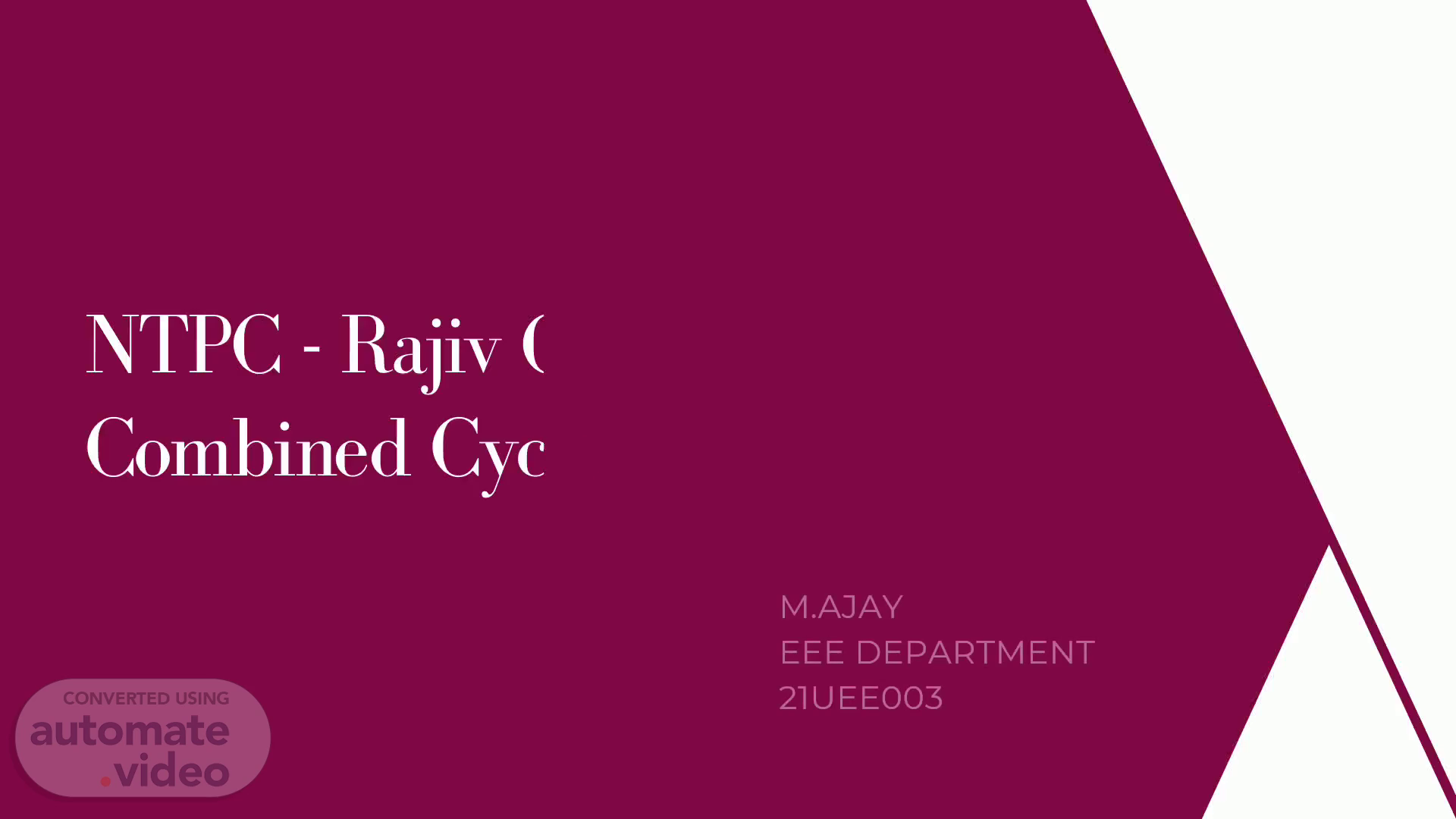
NTPC - Rajiv Gandhi Combined Cycle Power Plant
Scene 1 (0s)
NTPC - Rajiv Gandhi Combined Cycle Power Plant. M.AJAY EEE DEPARTMENT 21UEE003.
Scene 2 (8s)
OVERVIEW. NTPC (National Thermal Power Corporation) is one of India's largest power generation companies, contributing significantly to the country's energy needs. The Rajiv Gandhi Combined Cycle Power Plant is a state-of-the-art facility operated by NTPC, located in Haripad,Alappuzha district,Kerala. The plant utilizes a combined cycle technology to generate electricity efficiently and sustainably..
Scene 3 (26s)
NTPC'S MISSION AND VISION. Mission: NTPC is committed to providing reliable power at competitive prices in a sustainable and socially responsible manner. Vision: To be the world's leading power company, energizing India's growth and contributing to a cleaner and greener planet..
Scene 4 (41s)
The power plant is owend by NTPC limited .The power plant is fueled by imported and indigenous naphtha.Total installed capacity of the plant is 350MW. The plant is the combined cycle power plant comprising of two gas Turbines and one steam turbines of capacity 115MW and 120MW ..
Scene 5 (59s)
THERMODYNAMIC CYCLES. CARNOT CYCLE. RANKINE CYCLE.
Scene 6 (1m 9s)
CARNOT CYCLE A Carnot cycle is defined as an ideal reversible closed thermodynamic cycle. IN A CARNOT CYCLE, A SYSTEM TRANSFERS ENERGY IN THE FORM OF HEAT BETWEEN TWO THERMAL RESERVOIRS AT TEMPERATURES A PART OF THIS TRANSFERRED ENERGY IS CONVERTED TO THE WORK DONE BY THE SYSTEM..
Scene 7 (1m 24s)
CARNOT CYCLE.
Scene 8 (1m 30s)
When a Carnot cycle is plotted on the isothermal stages follow the isotherm lines for the working fluid, the adiabatic stages move between isotherms, and the area bounded by the complete cycle path represents the total work that can be done during one cycle..
Scene 9 (1m 46s)
The Rankine cycle closely describes the process by which steam engines commonly found in thermal power generation plants harness the thermal energy of a fuel or other heat source to generate electricity..
Scene 10 (1m 58s)
LAYOUT OF RANKINE CYCLE. PUMP BOILER TURBINE CONDENSER.
Scene 11 (2m 6s)
Isentropic compression Isobaric Heat addition Isentropic expansion Isobaric Heat rejection.
Scene 12 (2m 14s)
TS DIAGRAM.
Scene 13 (2m 20s)
BRAYTON CYCLE The Brayton cycle is a thermodynamic cycle that describes the operation of certain heat engines that have air or some other gas as their working fluid . The original Brayton engines used a piston compressor and piston expander, but modern gas turbine engines and airbreathing jet engines also follow the Brayton cycle..
Scene 14 (2m 37s)
ISENTROPIC COMPRESSION REVERSIBLE HEAT ADDITION ISENTROPOIC EXPANSION REVERSIBLE HEAT REJECTION.
Scene 15 (2m 45s)
PV / TS DIAGRAM.
Scene 16 (2m 52s)
POWER GENERATION AT RGCCPP The Rajiv Gandhi Combined Cycle Power Plant employs a combined cycle process that integrates both gas and steam turbines. The first stage involves the combustion of natural gas in the gas turbine, producing high-temperature exhaust gases. These hot gases are then used to produce steam, which drives a steam turbine, generating additional electricity.
Scene 17 (3m 9s)
ENVIRONMENTAL IMPACT. NTPC places a strong emphasis on environmental sustainability, and the Rajiv Gandhi Combined Cycle Power Plant is designed to be eco-friendly. Advanced emission control technologies, such as selective catalytic reduction (SCR) and flue gas desulfurization (FGD), are in place to reduce pollutants. The plant's low carbon footprint and efficient operations contribute to India's efforts to combat climate change..
Scene 18 (3m 29s)
FUEL SOURCE. The Rajiv Gandhi Combined Cycle Power Plant primarily relies on natural gas as its fuel source. Natural gas is a clean-burning fossil fuel, ensuring lower greenhouse gas emissions compared to coal-based power plants. NTPC ensures a stable supply of natural gas through strategic partnerships and long-term contracts..
Scene 19 (3m 45s)
INTEGRATION OF RENEWABLE ENERGY. As part of NTPC's commitment to sustainability, the plant is exploring the integration of renewable energy sources. The company is actively investing in solar, wind, and other renewable projects to complement the combined cycle power generation. This hybrid approach aims to enhance energy security and reduce greenhouse gas emissions further..
Scene 20 (4m 3s)
BENEFITS OF NTPC. The NTPC - Rajiv Gandhi Combined Cycle Power Plant has had a significant impact on the local economy, creating job opportunities and promoting energy security. The power plant has created over 1,500 direct jobs and over 5,000 indirect jobs in the region, providing a boost to the local economy..
Scene 21 (4m 20s)
The Rajiv Gandhi Combined Cycle Power Plant exemplifies NTPC's commitment to sustainable and efficient power generation. It plays a crucial role in meeting India's energy needs while contributing to a greener and cleaner environment. NTPC remains dedicated to powering India's progress with responsible and innovative energy solutions..